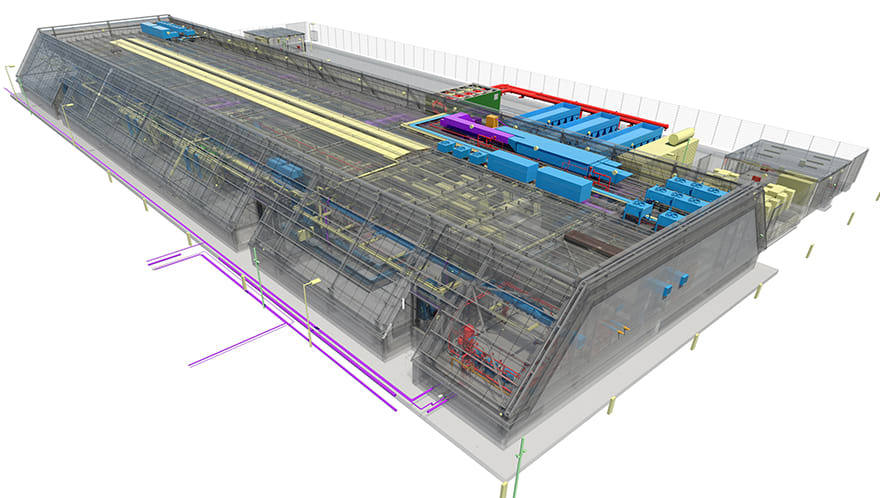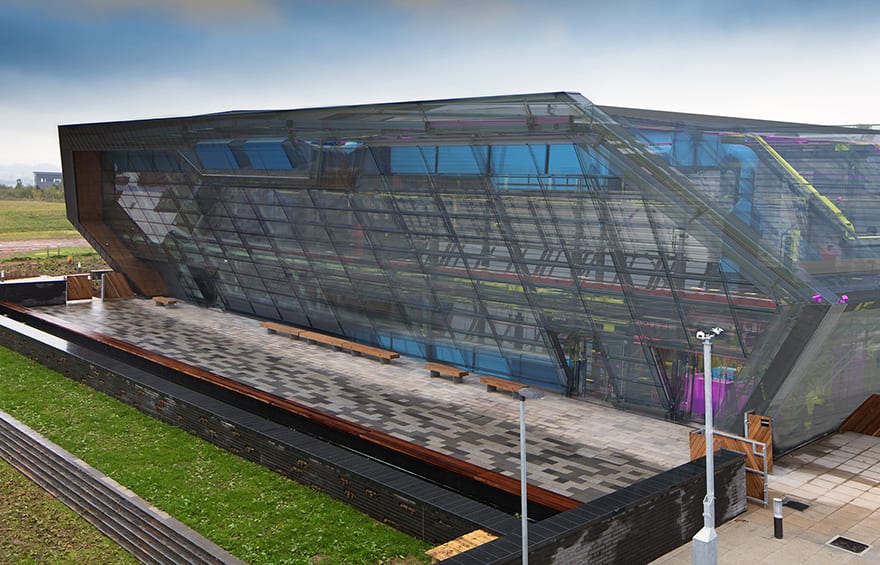- Client: Met Office
- Lead Contractor: Willmott Dixon
- BIM Tools: Revit, Solibri, BIM Collab
This cutting-edge 3,000 sq m facility located on Exeter Science Park will house a £97m supercomputer weighing 140 tonnes, which will perform 16,000 trillion calculations per second as part of efforts to better understand the workings of our climate.
Next door, the world’s brightest and best scientists will gather in the two-storey Collaboration building – a hexagon-shaped construction inspired by patterns in computer-circuitry and turquoise neon-lights in the movie Tron.
The futuristic nature of the facility drove the brief to deliver a full BIM Level 2 project to comply with the latest suite of BS and PAS 1192 standards. Stride Treglown led the entire BIM process, from RIBA Plan of Works Stage 3 to completion, acting as lead BIM coordinator and lead information manager.
The architect spent a long period of time developing “rule sets” in Solibri to optimise the clash detection process for architecture, structure and M&E models, to ensure no corners were cut. All coordination errors were uploaded to the online server “BIM Collab”, which streamlined clash reporting by allowing each team member to download clashes directly into Revit to rectify and synchronise back to the cloud.
The process saved money before construction started, comments Tom Gould, BIM coordinator at Stride Treglown: “We were able to identify clashes before reaching site and turn clash detection reports around faster than normal. BIM Collab is interoperable, with a plug-in for Revit, Tekla and most other software platforms on market, making it possible to collaborate easily using IFC files.”
Beyond design coordination, the Met Office wanted to optimise facilities management by adopting a COBie deliverable with a data-rich 3D model and supporting digital documentation.

The supercomputer IT hall features a large amount of M&E equipment
Stride and main contractor Willmott Dixon engaged with the client early on to develop a set of Asset Information Requirements and establish important items in terms of maintenance and operation post-handover, the level of detail and information required in the model.
Ralph James at the Met Office comments: “Working directly with Tom Gould and the team allowed us to establish early engagement with our CAFM supplier, to ensure our vision for the future use of the information outputs from the model would be of long-term value, with a more agile management of our assets.”
The supercomputer IT hall features a large amount of M&E equipment – services contractor NG Bailey sourced the majority of information and model objects from suppliers and product manufacturers. In cases where 3D models not available, Stride or NG Bailey developed place holder models with data attached so everything could exist in the native Revit model.
The process involved using Solibri as a COBie data validation tool to ensure that Level of Information requirements were met and that each component had the correct parameters filled in. “Effectively we were validating model completeness, not necessarily the validity of the information,” says Gould. “However, Willmott Dixon took responsibility for ensuring that the information input was correct.”

The two-storey Collaboration building is a hexagon-shaped construction inspired by patterns in computer-circuitry
A key challenge was to develop a manual workflow to transfer COBie information and data into Revit. The COBie Toolkit extension for Revit was used to export Excel spreadsheets, with all relevant parameters for each category in the BIM model, such as doors, walls etc.
Willmott Dixon then collected the relevant data from manufacturers and entered it manually into the spreadsheets. The software tool CTC Suite then automatically pushed the Excel data back into Revit.
The end result is one of the few fully-integrated COBie exchange 6 reports in existence, containing information such as bar codes, serial numbers, warranty start dates, replacement costs, and other extra parameters not covered by COBie.
All data links directly to the native Revit model for future use by the client, says Gould: “It was important that data was able to live in the 3D model, as well as the spreadsheet, because the Met Office may want to use the model within the next five years to manage the facility on day-to-day basis using CAD FM software.”
The Asset Information Model will provide a platform for future Met Office projects on the site, helping to save money when identifying requirements. James concludes: “Perhaps most importantly, the use of BIM provides the opportunity for future contractors to federate their work and offer more efficient planned delivery of change activity as the site evolves.”
We were able to identify clashes before reaching site and turn clash detection reports around faster than normal. BIM Collab is interoperable, with a plug-in for Revit, Tekla and most other software platforms on market, making it possible to collaborate easily using IFC files.– Tom Gould, Stride Treglown











